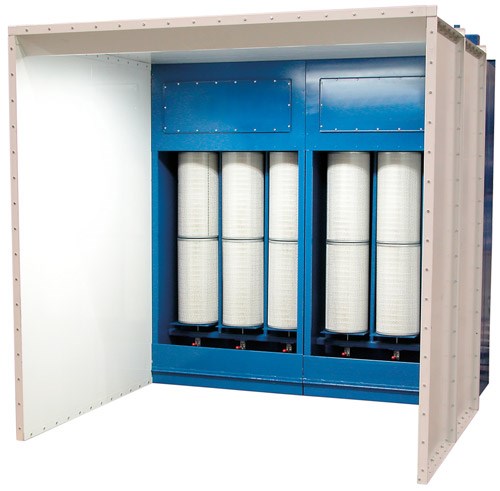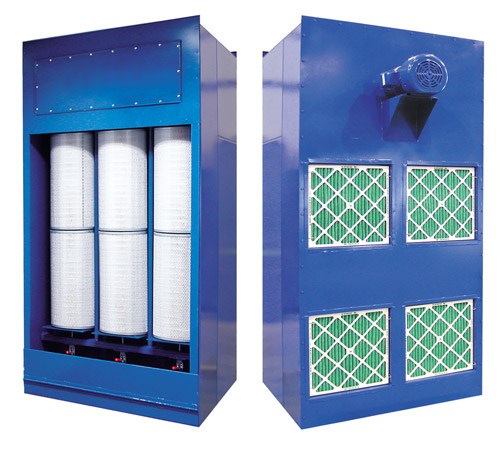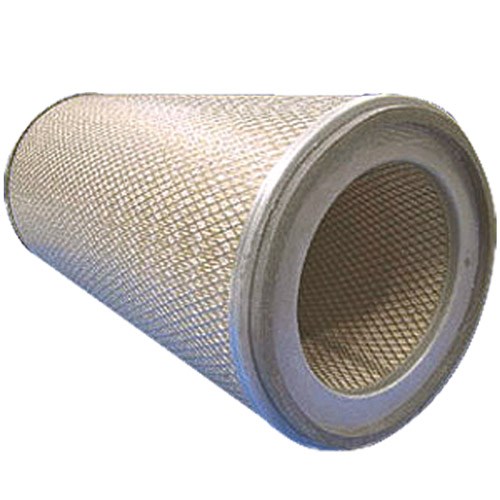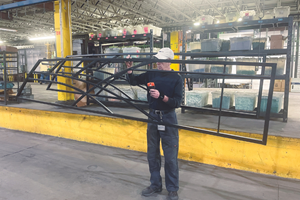Powder reclaim booths are designed with reuse of the coating material as a consideration of the booth’s performance. In these systems, cylindrical cartridges are used to trap overspray from the powder delivery system and—through the operation of a reverse pulse of air—allow the excess powder to be discharged into a collection device for reuse.
The cost-effectiveness of these systems relies on several parts working together in order to provide a long process cycle and to reclaim a maximum amount of unused coating material.
The first filter stage used in most common reclaim systems is a cylindrical cartridge filter. These cartridges are available in many different media configurations such as, cellulose; 80/20 or 60/40 blended cellulose and spunbond polyester; 100 percent spunbond polyester; and coated media with Teflon, Gore-Tex, and aluminized coatings. There are also variations in the frame configurations that allow these products to be used in single- or double-stack applications and most of these require gaskets to ensure a proper seal and fit.
Selecting Proper Media
One of the most critical considerations when using a cartridge filter is selecting the media for the filter that best fits the needs of the customer and the application. Considerations for initial expense, service life, durability, release quality and energy cost are just as critical as they would be in any maintenance environment.
Cellulose media and cellulose/polyester blended media are the most common types used in cylindrical cartridges, largely for the low initial cost and versatility in many applications. One hundred percent spunbond polyester is also popular for its superior release capabilities in reclaim powder coating applications. In a system where the cost of reclaimed coating is a critical concern, this media can reduce the amount of coating material that remains stuck in the cartridge when it is disposed, thereby reducing operating costs.
Other media styles are not as prevalent in powder coating operations, but may offer advantages in durability and the ability to release material based on individual application and type of material to be collected or reclaimed.
High Efficiency Final Filter
The second filter stage consists of a high efficiency final filter that protects the work environment from the accidental discharge of powder material should a blow-out, bypass, or leak occur in the first filter stage. This second stage filter can range in efficiency from MERV14-16, or F8-F9, depending on the equipment and local compliance requirements, and is available in many media types and frame styles and configurations. The most common type is a box-style frame, but single-header models are also used, and will typically use a retention device like a reverse frame, or bar, with threaded rods to ensure a proper seal and filter to frame fit.
On any filter application, questions arise as to what may require a filter to be changed. The most common answer is that this filter has reached its maximum service life based on resistance to air flow (differential pressure), or by reaching an established maintenance time cycle. There are occasions where this occurs prematurely, relative to established maintenance history. When such a situation arises, the logical process for determining why is to look at the system and how each of the parts is designed to work together.
Filters are fairly simple devices. If properly made, a filter will simply load until such time as it reaches its maximum usable life, or in exceeding that, fails due to the cumulative pressures created by loading and air flow. Filters are however, subject to failure, or reduced service life through other methods as well.
Two Filter Systems Work as One
In the typical powder system described at the beginning, two filter systems must work jointly to provide the proper operation of the powder reclaim booth. If the final filter is subjected to high concentrations of powder it will reach its final resistance; requiring a filter change. But what caused the high concentrations of powder? After all, according to our system approach, this filter is only used as a last resort to protect the space from contamination by the powder coating material. So why has that filter been loaded at all?
The cause and effect in this scenario is relatively easy to determine. The cartridge filter system has failed to perform as designed in some manner. What we need to determine is how that occurred and what can be done to correct the situation. Has the cartridge filter system failed due to a filter rupture, or leak in the media? Has it been incorrectly installed and bypass is occurring at the mounting surface, or gasket location? Has a leak developed in the filter plenum that is allowing coating material to bypass the first stage of filters?
These questions are what should be answered first, since it must be assumed that if these filters are performing correctly, then the second stage filter should not normally be challenged with any significant amount of powder coating material.
A leak in the filter itself may be very difficult to determine once it’s been in use, but there are tell-tale signs on the interior of the cylinder that may point to areas of leakage or holes in the media. Discoloration would be evidenced against the color of the media and could be seen upon removal of the cartridge and inspection of the filters interior surfaces.
Identifying Leaks
Leaks in the filter to frame mount can be identified by small burst patterns around the filter to frame mounting surface, either on the upstream where the back pulse would create the leakage indication, or on the downstream, where the vacuum pressure would create the leakage indication. Worn gasket material, incorrect gasket type, or improper installation of the filter can all contribute to this condition; as could overpressure from a cartridge filter that is loaded and is being operated beyond its pressure limitation.
In the case of overpressure from the cartridge filter, there is a logical explanation for the occurrence. If we recall, the filter is designed to discharge accumulated powder material by the use of a back pulse of air pressure supplied to the individual cartridges. It is possible that this pulse is not occurring as designed, or is improperly sequenced in that the back pulse merely moves the powder from one cartridge to another. More likely however, is that the powder is not properly discharging from the pleats in the cartridge filter; a process called “mudding,” or “bridging.”
This may be caused by excessive moisture, either in the booth environment or possible in the air supply used for the back pulse, or it may be the cause of the pleat spacing being too close together. A high capacity filter may instigate this occurrence when the intended effect is to create a longer service life because of the increase in surface area and decrease in operating pressure. It might also be caused by the type of media in use for that application and / or environment. Remember that the media used in the cartridge may contribute to mudding or bridging under certain conditions and an alternative media type may be the solution.
These same leak and mounting problems could also occur in the final filter and similar evidence should be sought if that concern arises, but in any case where filter life is a concern, it is just good business practice to examine the system for the problems indicated above, before changing the type of filters or the efficiency of the filters, in an effort to resolve the issue. More often than not in that approach the real problem will be ignored and continue to cost more money for maintenance and parts.
Mike Snow is filter sales manager at Global Finishing Solutions. He can be reached at 800-848-8738 or at globalfinishing.com.























